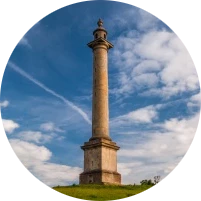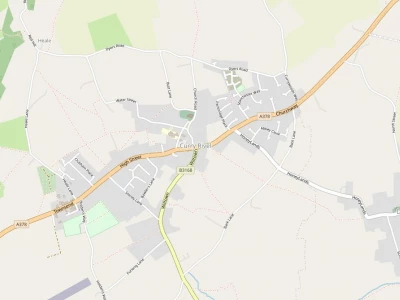This tranquil part of Somerset has been the scene of fierce fighting, rural struggle and successful trade.
Sir Richard Rivell, the lord of the manor in 1216, is said to have given the village his name, together with the title of Curry which also blesses North Curry and Curry Mallet and means village.
It is said that the name of Somerset originates from the time when it would only have been possible to cross large areas of our county during the summer when water levels had fallen. Several of our oldest local villages stood on hills like islands set in the sea, and the ending of 'ney' on the village names indicate that they were once islands for much of the year (eg. Muchelney, Athelney). Thanks to the peat that still covers large tracts of land, we can see how man managed to cross from one area of high land to another. Archaeologists have discovered remarkably well-preserved wooden pathways used by ancient man to exploit the marshes. The six-thousand-year-old 'Sweet Track' from the Polden Hills to Westhay is the earliest known man-made track in the world.
The ancient Celts of Wessex found themselves benefiting from the natural barrier of the marshes as invaders such as the Saxons tried to press into Devon and Cornwall. The only causeway across was built by the Romans at Langport, two miles from Curry Rivel, and the Celts managed to defend it. It is hard to imagine, as one stands by the meandering river at Langport, that this spot witnessed great violence. In 530 King Arthur is said to have fought the Saxons there, and then in 787AD the Saxons tried to fight off the Danes, who sacked and burnt Langport. Langport was indeed a port and an important market until roads much later took over from the river. The English King Alfred and the spread of Christianity calmed the struggles with the Saxons and Danes, and relative peace descended until the Norman invasion in 1066.
William the Conqueror took decisive action across England and understood that land and religion were the keys to power. Norman soldiers were given land and they became the new aristocracy. Sir Richard Rivell became Lord of the Manor and the lands around here early in the 13th century, and it is at this point that our village became an entity. He lived at Midelney, where an Elizabethan manor stands today. Villagers lost their freedom, and endured an orderly but punishing regime under the Norman feudal system, working hard on land that they could never hope to own.
The fine Church of St Andrews that stands behind the village green is a happier legacy of these years.
Both the Church and commerce became more organised, and the Abbeys of Glastonbury, Wells, Athelney and Muchelney wanted to make more of the enormous areas of land that they had acquired. During the thirteenth century it was the monks who had the inclination and manpower to drain the area, and so our characteristic grid of water channels, or 'rhynes' (pronounced 'reens') began to take shape. The Abbey at Muchelney just three miles away would have been the most powerful influence over Curry Rivel during those years. The Abbey was destroyed by Henry VIII's Reformation, but its foundations and the Abbot's House remain. Glastonbury Abbey has a fascinating display in its Museum which tells the story of the monks' reclamation of the land from the sea.
There is much evidence of successful trade in the area, and of an early bank in Langport, with wool and cloth being traded and transported on the river. These developments were destined for further interruptions, however, as the Civil War tore local families apart as it had across England, and the Battle of Langport took place in 1645, the last battle of that war. Then, in 1685, the Duke of Monmouth landed at Lyme Regis to challenge King James II and their forces met at the Battle of Sedgemoor. Men from Curry Rivel would have been among the casualties of those battles.
The history which seems most tangible to us today is that of the continued struggle with floodwater. Farmers and the Environment Agency have learned to co-operate in establishing a balance that preserves the natural and unique ecosystem of the Levels, while not preventing landowners from making a living. Water levels are controlled by a network of pumping stations.
The use of the land in and around Curry Rivel has always been dictated by its susceptibility to flooding. Throughout history landowners would work around fields becoming flooded and remaining under water for weeks during the winter. It is said that, in areas that flood regularly, there are two different ecosystems on the same piece of land during dry and wet periods, and farmers (and wildlife) have learned how to make the most of these. Higher ground was used for apple orchards, cattle or sheep, or crops, and until fresh water was available farm workers used to drink two pints of cider a day.
Wet conditions are ideal for growing withies, which are still planted as willow shoots for an annual crop. They could be, and are still today, picked 'green' or 'black' depending on the flexibility and colour required for their intended use, and also treated and stored in different ways. Until the last generation, large numbers of local men would have been employed in the annual withy harvest, and stacks of withies could be seen drying. The pollarded willow is a typical feature of our landscape, as is the gate that appears to stand alone in the middle of a field. The rhynes act as hedges dividing the fields, and the gates secure a bridge of land between them.
Today making a living from land locally is still challenging, for different reasons. However, traditional withy growing has seen a modest revival, and traditional farming sits comfortably alongside more modern developments such as campsites, bed and breakfast, farm holidays, and cycle holidays that make the most of our flat landscape. Many talented craftspeople can also be found, such as the world-famous potter John Leach and other makers of pottery, furniture and specialist produce such as smoked eels, cider and cider brandy that keep traditional skills alive.
Get In Touch
CurryRivelOnline is powered by our active community.
Please send us your news and views.
Email: editor@curryrivel.org.uk

